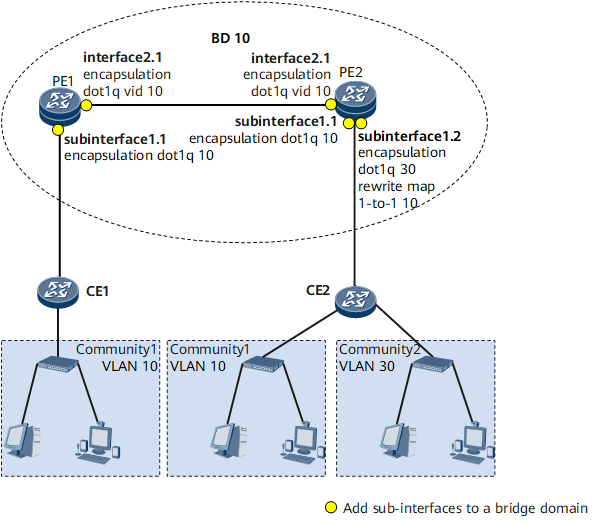Example for Establishing an EVC Model
This section provides an example for establishing an EVC model to implement inter-VLAN communication.
Networking Requirements
If various communities share the same services, such as Internet, Internet Protocol Television (IPTV), and Voice Over IP (VoIP), to facilitate management, each service can be assigned a VLAN in each community. The same service may be assigned different VLANs in different communities.
On the network shown in Figure 1, community 1 and community 2 have the same services. A service of the two communities is transmitted using the same VLAN, but a service is transmitted using different VLANs in the two communities. Devices using the same service but in different VLANs in the two communities need to communicate. To meet this requirement, an EVC model can be deployed, which has a low cost.
Configuration Roadmap
The configuration roadmap is as follows:
- Assign device interfaces in community 1 to VLAN10, and assign device interfaces in community 2 to VLAN30.
- Configure an EVC model on a PE:
- Configure a bridge domain to forward services.
- Create an EVC Layer 2 sub-interface, add it to the bridge domain, and specify traffic encapsulation types and behaviors on the EVC Layer 2 sub-interface.
Data Preparation
- Number of each interface connecting each device to users
- Number of each interface connecting each device to another device
- ID of each VLAN to which each interface belongs
- Bridge domain ID
Procedure
- Assign interfaces connecting each CE to users to a specified VLAN.
# Configure CE1.
<HUAWEI> system-view [~HUAWEI] sysname CE1 [*HUAWEI] commit [~CE1] vlan 10 [*CE1-vlan10] quit [*CE1] interface gigabitethernet 0/1/1 [*CE1-GigabitEthernet0/1/1] undo shutdown [*CE1-GigabitEthernet0/1/1] portswitch [*CE1-GigabitEthernet0/1/1] port link-type access [*CE1-GigabitEthernet0/1/1] port default vlan 10 [*CE1-GigabitEthernet0/1/1] quit [*CE1] interface gigabitethernet 0/1/2 [*CE1-GigabitEthernet0/1/2] undo shutdown [*CE1-GigabitEthernet0/1/2] portswitch [*CE1-GigabitEthernet0/1/2] port link-type trunk [*CE1-GigabitEthernet0/1/2] port trunk allow-pass vlan 10 [*CE1-GigabitEthernet0/1/2] quit [*CE1] commit
# Configure CE2.
<HUAWEI> system-view [~HUAWEI] sysname CE2 [*HUAWEI] commit [~CE2] vlan batch 10 30 [*CE2] interface gigabitethernet 0/1/1 [*CE2-GigabitEthernet0/1/1] undo shutdown [*CE2-GigabitEthernet0/1/1] portswitch [*CE2-GigabitEthernet0/1/1] port link-type access [*CE2-GigabitEthernet0/1/1] port default vlan 30 [*CE2-GigabitEthernet0/1/1] quit [*CE2] interface gigabitethernet 0/1/3 [*CE2-GigabitEthernet0/1/3] undo shutdown [*CE2-GigabitEthernet0/1/3] portswitch [*CE2-GigabitEthernet0/1/3] port link-type access [*CE2-GigabitEthernet0/1/3] port default vlan 10 [*CE2-GigabitEthernet0/1/3] quit [*CE2] interface gigabitethernet 0/1/2 [*CE2-GigabitEthernet0/1/2] undo shutdown [*CE2-GigabitEthernet0/1/2] portswitch [*CE2-GigabitEthernet0/1/2] port link-type trunk [*CE2-GigabitEthernet0/1/2] port trunk allow-pass vlan 10 30 [*CE2-GigabitEthernet0/1/2] quit [*CE2] commit
- Establish an EVC model.
Configure a bridge domain on each PE.
# Configure PE1.
<HUAWEI> system-view [~HUAWEI] sysname PE1 [*HUAWEI] commit [~PE1] bridge-domain 10 [~PE1-bd10] quit
# Configure PE2.
<HUAWEI> system-view [~HUAWEI] sysname PE2 [*HUAWEI] commit [~PE2] bridge-domain 10 [~PE2-bd10] quit
Create an EVC Layer 2 sub-interface on each PE, add the EVC Layer 2 sub-interface to a bridge domain, and specify traffic encapsulation and behaviors on the EVC Layer 2 sub-interface.
# Configure PE1.
[*PE1] interface gigabitethernet 0/1/1 [*PE1-GigabitEthernet0/1/1] undo shutdown [*PE1-GigabitEthernet0/1/1] quit [*PE1] interface gigabitethernet 0/1/1.1 mode l2 [*PE1-GigabitEthernet0/1/1.1] encapsulation dot1q vid 10 [*PE1-GigabitEthernet0/1/1.1] bridge-domain 10 [*PE1-GigabitEthernet0/1/1.1] quit [~PE1] interface gigabitethernet 0/1/2 [*PE1-GigabitEthernet0/1/2] undo shutdown [*PE1-GigabitEthernet0/1/2] quit [*PE1] interface gigabitethernet 0/1/2.1 mode l2 [*PE1-GigabitEthernet0/1/2.1] encapsulation dot1q vid 10 [*PE1-GigabitEthernet0/1/2.1] bridge-domain 10 [*PE1-GigabitEthernet0/1/2.1] commit [~PE1-GigabitEthernet0/1/2] quit
# Configure PE2.
[*PE2] interface gigabitethernet 0/1/1 [*PE2-GigabitEthernet0/1/1] undo shutdown [*PE2-GigabitEthernet0/1/1] quit [*PE2] interface gigabitethernet 0/1/1.1 mode l2 [*PE2-GigabitEthernet0/1/1.1] encapsulation dot1q vid 10 [*PE2-GigabitEthernet0/1/1.1] bridge-domain 10 [*PE2-GigabitEthernet0/1/1.1] quit [*PE2] interface gigabitethernet 0/1/1.2 mode l2 [*PE2-GigabitEthernet0/1/1.2] encapsulation dot1q vid 30 [*PE2-GigabitEthernet0/1/1.2] rewrite map 1-to-1 vid 10 [*PE2-GigabitEthernet0/1/1.2] bridge-domain 10 [*PE2-GigabitEthernet0/1/1.2] quit [~PE2] interface gigabitethernet 0/1/2 [*PE2-GigabitEthernet0/1/2] undo shutdown [*PE2-GigabitEthernet0/1/2] quit [*PE2] interface gigabitethernet 0/1/2.1 mode l2 [*PE2-GigabitEthernet0/1/2.1] encapsulation dot1q vid 10 [*PE2-GigabitEthernet0/1/2.1] bridge-domain 10 [*PE2-GigabitEthernet0/1/2.1] commit [~PE2-GigabitEthernet0/1/2] quit
- Verify the configuration.
After completing the configuration, run the display bridge-domain command to view bridge domain information, including the bridge domain to which an EVC Layer 2 sub-interface belongs and the bridge domain status. The following example uses the command output on PE1.
[~PE1] display bridge-domain The total number of bridge-domains is : 1 -------------------------------------------------------------------------------- MAC_LRN: MAC learning; STAT: Statistics; SPLIT: Split-horizon; BC: Broadcast; MC: Unknown multicast; UC: Unknown unicast; *down: Administratively down; FWD: Forward; DSD: Discard; -------------------------------------------------------------------------------- BDID State MAC-LRN STAT BC MC UC SPLIT Description -------------------------------------------------------------------------------- 10 up enable disable FWD FWD FWD disableRun the display ethernet uni information command to view information about traffic encapsulation types and behaviors configured on an EVC Layer 2 sub-interface. The following example uses the command output on PE2.
[~PE2] display ethernet uni information GigabitEthernet0/1/1.1 Total encapsulation number: 1 encapsulation dot1q vid 10 No action GigabitEthernet0/1/1.2 Total encapsulation number: 1 encapsulation dot1q vid 30 Rewrite map 1-to-1 vid 10 GigabitEthernet0/1/2.1 Total encapsulation number: 1 encapsulation dot1q vid 10 No action
With the EVC model, users in two communities can communicate across VLANs.
Configuration Files
PE1 configuration file
# sysname PE1 # bridge-domain 10 # interface GigabitEthernet0/1/1 undo shutdown # interface GigabitEthernet0/1/1.1 mode l2 encapsulation dot1q vid 10 bridge-domain 10 # interface GigabitEthernet0/1/2 undo shutdown # interface GigabitEthernet0/1/2.1 mode l2 encapsulation dot1q vid 10 bridge-domain 10 # return
PE2 configuration file
# sysname PE2 # bridge-domain 10 # interface GigabitEthernet0/1/1 undo shutdown # interface GigabitEthernet0/1/1.1 mode l2 encapsulation dot1q vid 10 bridge-domain 10 # interface GigabitEthernet0/1/1.2 mode l2 encapsulation dot1q vid 30 rewrite map 1-to-1 vid 10 bridge-domain 10 # interface GigabitEthernet0/1/2 undo shutdown # interface GigabitEthernet0/1/2.1 mode l2 encapsulation dot1q vid 10 bridge-domain 10 # return
CE1 configuration file
# sysname CE1 # vlan batch 10 # interface GigabitEthernet0/1/1 portswitch undo shutdown port link-type access port default vlan 10 # interface GigabitEthernet0/1/2 portswitch undo shutdown port link-type trunk port trunk allow-pass vlan 10 # return
CE2 configuration file
# sysname CE2 # vlan batch 10 30 # interface GigabitEthernet0/1/1 portswitch undo shutdown port link-type access port default vlan 30 # interface GigabitEthernet0/1/2 portswitch undo shutdown port link-type trunk port trunk allow-pass vlan 10 30 # interface GigabitEthernet0/1/3 portswitch undo shutdown port link-type access port default vlan 10 # return

